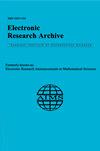A modified FGL sparse canonical correlation analysis for the identification of Alzheimer's disease biomarkers
IF 1
4区 数学
Q1 MATHEMATICS
引用次数: 0
Abstract
Imaging genetics mainly finds the correlation between multiple datasets, such as imaging and genomics. Sparse canonical correlation analysis (SCCA) is regarded as a useful method that can find connections between specific genes, SNPs, and diseased brain regions. Fused pairwise group lasso-SCCA (FGL-SCCA) can discover the chain relationship of genetic variables within the same modality or the graphical relationship between images. However, it can only handle genetic and imaging data from a single modality. As Alzheimer's disease is a kind of complex and comprehensive disease, a single clinical indicator cannot accurately reflect the physiological process of the disease. It is urgent to find biomarkers that can reflect AD and more synthetically reflect the physiological function of disease development. In this study, we proposed a multimodal sparse canonical correlation analysis model FGL-JSCCAGNR combined FGL-SCCA and Joint SCCA (JSCCA) method which can process multimodal data. Based on the JSCCA algorithm, it imposes a GraphNet regularization penalty term and introduces a fusion pairwise group lasso (FGL), and a graph-guided pairwise group lasso (GGL) penalty term, the algorithm in this paper can combine data between different modalities, Finally, the Annual Depression Level Total Score (GDSCALE), Clinical Dementia Rating Scale (GLOBAL CDR), Functional Activity Questionnaire (FAQ) and Neuropsychiatric Symptom Questionnaire (NPI-Q), these four clinical data are embedded in the model by linear regression as compensation information. Both simulation data and real data analysis show that when FGI-JSCCAGNR is applied to the imaging genetics study of Alzheimer's patients, the model presented here can detect more significant genetic variants and diseased brain regions. It provides a more robust theoretical basis for clinical researchers.一种用于识别阿尔茨海默病生物标志物的改进FGL稀疏典型相关分析
成像遗传学主要寻找成像和基因组学等多个数据集之间的相关性。稀疏典型相关分析(SCCA)被认为是一种有效的方法,可以发现特定基因、snp和病变脑区域之间的联系。FGL-SCCA (Fused pairwise group lasso-SCCA)可以发现同一模态内遗传变量的链关系或图像之间的图形关系。然而,它只能处理来自单一模式的遗传和成像数据。阿尔茨海默病是一种复杂的综合性疾病,单一的临床指标不能准确反映疾病的生理过程。迫切需要寻找能够反映AD的生物标志物,更综合地反映疾病发展的生理功能。本研究提出了一种结合FGL-SCCA和Joint SCCA (JSCCA)方法的多模态稀疏典型相关分析模型FGL-JSCCAGNR,可以处理多模态数据。本文算法在JSCCA算法的基础上,引入GraphNet正则化惩罚项,并引入融合两两组套索(FGL)和图导两两组套索(GGL)惩罚项,实现了不同模式间数据的组合。最后,将年度抑郁水平总分(GDSCALE)、临床痴呆评定量表(GLOBAL CDR)、功能活动问卷(FAQ)和神经精神症状问卷(NPI-Q)这四个临床数据通过线性回归作为补偿信息嵌入到模型中。仿真数据和真实数据分析均表明,将FGI-JSCCAGNR应用于阿尔茨海默病患者的成像遗传学研究时,本文模型可以检测到更显著的遗传变异和病变脑区。为临床研究者提供了更为有力的理论依据。
本文章由计算机程序翻译,如有差异,请以英文原文为准。
求助全文
约1分钟内获得全文
求助全文

 求助内容:
求助内容: 应助结果提醒方式:
应助结果提醒方式:


